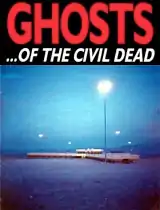Ghosts… of the Civil Dead
Ghosts... of the Civil Dead is a 1988 Australian drama-suspense film directed by John Hillcoat. It was written by Hillcoat, Evan English, Gene Conkie, Nick Cave and Hugo Race. It is partly based on the true story of Jack Henry Abbott.
| Ghosts... of the Civil Dead | |
|---|---|
 Theatrical release poster | |
| Directed by | John Hillcoat |
| Written by | Nick Cave Gene Conkie Evan English John Hillcoat Hugo Race |
| Produced by | Evan English |
| Starring | David Field Chris DeRose Nick Cave Dave Mason |
| Cinematography | Paul Goldman Graham Wood |
| Edited by | Stewart Young |
| Music by | Nick Cave Blixa Bargeld Mick Harvey |
Production companies | Correctional Services Outlaw Values |
Release date |
|
Running time | 93 minutes |
| Country | Australia |
| Language | English |
| Budget | A$1,680,000[1] |
Synopsis
The story is set in Central Industrial Prison, a privately run maximum security prison in the middle of the Australian desert. An outbreak of violence within the prison has resulted in a total lockdown. A committee is appointed by the prison's governors to investigate the cause of the outbreak, but their findings are in stark contrast to the facts behind the riot.
It is revealed that both the prisoners and the guards are slowly and deliberately brutalised, manipulated and provoked into the forthcoming eruption of violence by the government and the private company that runs the prison, in order to justify the construction of a new and more "secure" facility.
Production
The script was based on the book In the Belly of the Beast by Jack Henry Abbott and research done with David Hale, a former prison guard at Marion, Illinois. The film was shot at a disused aircraft factory in Melbourne[2] in October and November.[3]
Origin of title
In Roman law, a person convicted of a crime where the punishment included loss of their legal rights as a person was civiliter mortuus, a person without civil rights.
Reception
Accolades
| Award | Category | Subject | Result |
|---|---|---|---|
| AACTA Awards (1989 Australian Film Institute Awards) |
Best Film | Evan English | Nominated |
| Best Original Screenplay | Nick Cave | Nominated | |
| John Hillcoat | Nominated | ||
| Hugo Race | Nominated | ||
| Gene Conkie | Nominated | ||
| Evan English | Nominated | ||
| Best Actor in a Leading Role | Mike Bishop | Nominated | |
| Best Actor in a Supporting Role | Bogdan Koca | Nominated | |
| Best Editing | Stewart Young | Nominated | |
| Best Original Music Score | Nick Cave | Nominated | |
| Mick Harvey | Nominated | ||
| Blixa Bargeld | Nominated | ||
| Best Sound | Bronwyn Murphy | Nominated | |
| Rex Watts | Nominated | ||
| Peter Clancy | Nominated | ||
| Best Production Design | Chris Kennedy | Won | |
| Best Costume Design | Karen Everett | Nominated | |
| Beverly Jasper | Nominated |
Legacy
The spoken line "Welcome to Central Industrial. We are the future" has been sampled by Future Sound of London in their song "Central Industrial" on their Accelerator album;[4] also sampled by Woob in their song "Void, Part One" on the album em:t 0094,[5] and by Jam and Spoon in their remix of Moby's "Go".[6]
Sonic Subjunkies samples various parts of the film in their songs "Central Industrial" and "Central Industrial II: The Lockdown".
Therapy? opened the song "Nausea" (the first one on their 1992 album Nurse) with a sample of Nick Cave shouting "Here I am, motherfuckers!" in the film.
Bibliography
- Fuchs, Christian [1996] (2002). Bad Blood. Creation Books
References
- "Production Survey", Cinema Papers, September 1987 p. 67.
- David Stratton, The Avocado Plantation: Boom and Bust in the Australian Film Industry, Pan MacMillan, 1990 pp. 229–230
- Jillian Burt, Ghosts... of the Civil Dead, Cinema Papers, March 1988 pp. 8–11.
- "The Future Sound of London". s107.net. Retrieved 12 April 2014.
- "Woob". s107.net. Retrieved 12 April 2014.
- "Moby". s107.net. Retrieved 12 April 2014.
External links
- Official website
- Ghosts... of the Civil Dead at IMDb
- Ghosts... of the Civil Dead at Oz Movies
- Ghosts... of the Civil Dead at AllMovie
- Ghosts… of the Civil Dead at Rotten Tomatoes
- Ghosts... of The Civil Dead at the National Film and Sound Archive